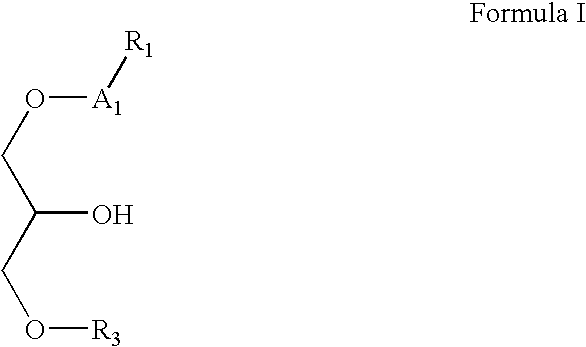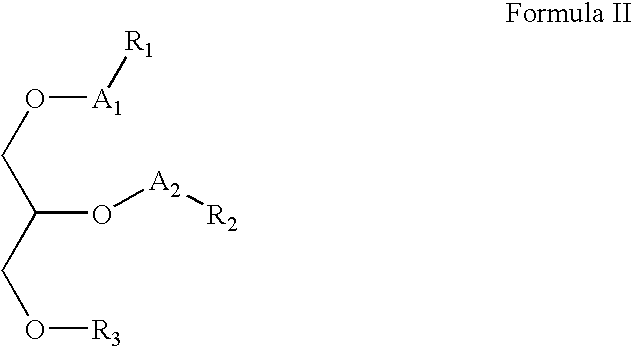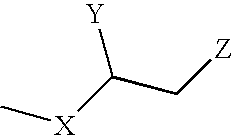Process for the preparation of oxidized phospholipids
a technology of phospholipids and phospholipids, which is applied in the field of synthetic chemistry, can solve the problems of low low specificity of reactions, and low yield of overall yield of multi-step synthetic pathways
- Summary
- Abstract
- Description
- Claims
- Application Information
AI Technical Summary
Benefits of technology
Problems solved by technology
Method used
Image
Examples
example 1
Preparation of rac-1-hexadecyl-2-(5′-pentanoic methyl ester)-glycerol using periodate and a Girard T reagent
[0331]In this example, an unsaturated moiety is introduced into a glycerolic backbone and is thereafter oxidized by means of formic acid, hydrogen peroxide and periodate. Then thus formed oxidized product is purified by means of a Girard reagent.
[0332]As a representative example, the preparation of rac-1-hexadecyl-2-(5′-pentanoic methyl ester)-glycerol is hereby described. rac-1-Hexadecyl-2-(5′-pentanoic methyl ester)-glycerol is prepared in accordance with the teachings of the present invention, as is described in Schemes I through V below.
[0333]1-Hexadecyl-3-tritylglycerol was prepared as described in U.S. Pat. No. 6,838,452. In brief, D-acetone glycerol (4 grams), powdered potassium hydroxide (approximately 10 grams) and hexadecyl bromide (9.3 grams) in benzene (100 ml) were stirred and refluxed for 5 hours, while removing the water formed by azeotropic distillation (compar...
example 2
Preparation of rac-1-hexadecyl-2-(5′-pentanoic methyl ester)-glycerol using periodate and an acetate protecting group
[0346]In this example, an unsaturated moiety is introduced into a glycerolic backbone and is thereafter oxidized to an ester via an epoxide by means of acetic anhydride, 4-chlorobenzoperoxoic acid, HClO4 periodate and methanol. Efficient isolation of the intermediates is performed by carrying out the reactions while using an acetate protecting group
[0347]As a representative example, the preparation of rac-1-hexadecyl-2-(5′-pentanoic methyl ester)-glycerol is hereby described.
[0348]rac-1-Hexadecyl-2-(5′-pentanoic methyl ester)-glycerol is prepared in accordance with the teachings of the present invention, as is described in Schemes VI through X below.
[0349]As depicted in Scheme VI below, 1-Hexadecyl-2-(5′-hexenyl)-3-tritylglycerol, prepared as described in Example 1 above (4.90 grams) was dissolved in a mixture of methanol (30 ml) and concentrated hydrochloric acid (3 ...
example 3
Preparation of rac-1-hexadecyl-2-(5′-pentanoic ethyl ester)-glycerol by direct introduction of an oxidized moiety—Route I
[0359]rac-1-Hexadecyl-2-(5′-pentanoic ethyl ester)-glycerol is prepared in accordance with the teachings of the present invention, as is described in Scheme XI below.
[0360]
[0361]1-Hexadecyl-3-tritylglycerol is prepared as described, for example, in Example 1 above or as described in U.S. Pat. No. 6,838,425.
[0362]To a three-necked flask equipped with a magnetic stirrer, 1.0 gram (1.8 mmole) 1-hexadecyl-3-tritylglycerol, 0.78 gram (3.6 mmole) 5-bromovaleric acid ethyl ester and 75 ml dimethylformarnide (DMF) are added. To the stirred solution, 0.20 gram (5 mmole) NaH (60% dispersion in mineral oil) dissolved in 25 ml dimethylformamide are added dropwise over 15 minutes and stirring is continued for an additional 1 hour until the reaction is completed. Water was added (50 ml) and the mixture extracted with ether (3×50 ml). The organic phase was dried over anhydrous N...
PUM
| Property | Measurement | Unit |
|---|---|---|
| volume | aaaaa | aaaaa |
| volumes | aaaaa | aaaaa |
| melting point | aaaaa | aaaaa |
Abstract
Description
Claims
Application Information
 Login to View More
Login to View More - R&D
- Intellectual Property
- Life Sciences
- Materials
- Tech Scout
- Unparalleled Data Quality
- Higher Quality Content
- 60% Fewer Hallucinations
Browse by: Latest US Patents, China's latest patents, Technical Efficacy Thesaurus, Application Domain, Technology Topic, Popular Technical Reports.
© 2025 PatSnap. All rights reserved.Legal|Privacy policy|Modern Slavery Act Transparency Statement|Sitemap|About US| Contact US: help@patsnap.com



